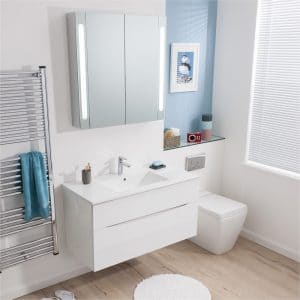Small Bathroom Designs
Some of us aren’t lucky enough to have a big bathroom. Small bathrooms can be challenging to design.
Some of us aren’t lucky enough to have a big bathroom. Small bathrooms can be challenging to design. Most bathrooms in period homes are on the small side and this causes storage problems especially for a family who need space for ‘things’ whether they have toddlers or teenagers. Here are my top ten tips for making and keeping space when designing a small bathroom.
If you have a solid wall between the bathroom and the next room you may be able to insert a recessed mirror cabinet. These are pricier than wall fix ones but where space is tight, they are a god send. Manufacturers of these include Keuco, Schneider and Roper Rhodes. Be sure to get the mirrored type, as mirrors will add the effect of space to the room.
Use larger, rather than smaller tiles. The smaller the tile, the more grout lines you’ll have, the more ‘cut up’ the space will look. 60cm x 60cm and 30cm x 60cm are good sizes for many small bathrooms. To avoid unsightly small cuts a tile layout needs to be planned out well before starting. Sometimes they can be laid diagonally or at 45 degrees across the floor which can fool the eye into thinking there is more space than when tiles are laid at right angles to the wall. Use of inset border tiles, such as mosaics can be made to make a room seem higher or wider. A low ceiling could be heightened by using vertical contrast tiles. However, often small spaces are best kept simple with tiling in one colour and to the ceiling. A neat, straight job is key with a bathroom. Tiles are the crowing glory of this room.
Colour is important in a small bathroom. Light walls are best, especially if the windows are small. Ivory, white and light grey are all good neutral choices for walls, though making one wall dark can give the effect of the room being larger. Glossy tiles give reflection from any spotlights or natural light and add a luxury feel. For floors, I favour medium to dark shades because light grout lines can get dirty over time, especially if not protected with an appropriate chemical. Medium greys to charcoals or browns are great. Neutral colours are best if you don’t want to keep updating your bathroom with changing fashions. Stick to a maximum of two colours for the floor and wall tiles and/or paint for a timeless, clean look. You can always bring in a bright splash of colour with bottles or other accessories.
Lighting is super important to get right in small spaces. Most small bathrooms will need around 6 ceiling spotlights, but if you are more limited buy a lit cabinet or mirror that gives extra light. Strip lighting can be added under a wall hung sink cabinet unit which can turn on via sensor. Spot lights can be inserted into shower plinths, bath panels, stud walls and floors. Placing spotlights about 20cm from a wall will give a fan light effect on that wall for easy and effective mood lighting.
If this is your only bathroom in the house and you can fit in a bath, it does make sense to do so. Not only is it practical, it will devalue your home to only have a shower. You can shower in a bath but you can’t bathe in a shower!
Recessed wall shelving is a great solution that provides storage space for shampoos and soaps. A long recessed shelf along the side of a bath can not only provide storage, but also wow factor, especially when lit with LED spotlights or with tea lights for a chill out evening bath soak.
Vanity units provide both a sink and a storage cupboard underneath. Lots of these can be wall hung which means the floor space is not used up, making the room appear bigger. There are so many on the market but the some of the best are those where the sink covers the whole of the top, rather than being inset. Water sitting on any porous surface will eventually damage it, so it makes sense for the sink material to cover any laminate wood construction.
Surface shelving has come a long way in recent years, with many sleek designs available. Towel and bottle racks come in a variety of sizes but with any of this, buying quality is the key. Some of these accessories are quite pricey, but the better quality ones will look better and last longer.
A towel radiator is handy not only for drying towels but for storing them. The ones I like are asymmetric and one side is ‘open’. This means you can neatly slide on a folded towel rather than pushing it through the rungs on traditional designs. The Zehnder Roda Spa is one of my favourites, can be right or left hand in design, and comes in several colours:







